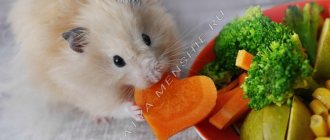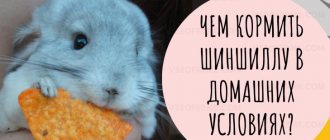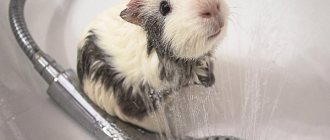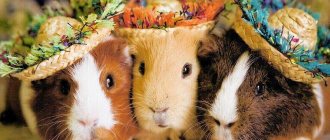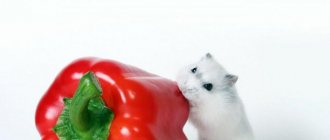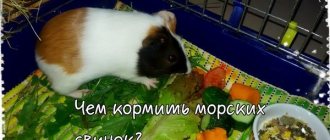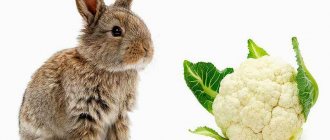Guinea pigs are highly sensitive pets that require careful care, love and attention from their owner. The digestive tract of rodents of this species is designed in such a way that for normal functioning and preservation of health, animals must receive the same food at home as they would receive in their natural habitat. The owner must clearly know what to feed the guinea pig. Adequate nutrition for an animal is a matter of vital importance. In a starving rodent, after a day, the intestines stop working, and the animal dies.
Feeding recommendations
The pet needs to be fed correctly so that its health remains normal, its teeth are strong, and its coat looks well-groomed. Your pet's daily menu should include:
- 50% hay;
- 20% dry food;
- 20% juicy food;
- 10% greens.
An important question for owners is how many times a day to give food to a guinea pig. Feeding is carried out 3 times a day. The feeder cannot be removed from the cage; food must always be available to the animal. There should also always be hay in the cage.
If there is no dry food in the animal’s diet, then it must be replaced with a similar weight of greens and raw vegetables. The menu should be varied; the rodent must be offered at least three different vegetables per day and certainly grass. It is prohibited to give your pet grass collected on the sides of highways and in industrial areas.
The optimal menu is vegetables and fruits before noon, dry food after noon.
Other
Among other things, it is worth mentioning that guinea pigs do not tolerate processed foods: fried, boiled, pickled, baked, canned. The owner must not feed the pet food from his table. Including sweets: chocolate, marshmallows, cookies, etc.
Other prohibited products include:
- mushrooms;
- sauces - ketchup, mustard, etc.;
- sorrel;
- plantain.
There are special sweets for rodents - drops. They come in different flavors - berry, citrus, vegetable. Pets really like them, they should be used carefully and offered occasionally, like regular fruits. Drops contain sugar, which is harmful to animals.
Before offering your pet something tasty, you should check the list of prohibited foods. If there is no information on a specific product, the best option is to put it aside and choose something else.
Its well-being and life expectancy depend on the proper organization of a guinea pig’s daily diet. There is a list of foods that should not be given to guinea pigs under any circumstances. Pet owners should know about this so as not to make a fatal mistake.
Grain feed
A guinea pig needs to eat at least 20% grain per day. Grain food for rodents is sold in any pet store. The finished product usually includes:
- barley;
- oats;
- millet;
- sunflower seeds;
- corn grains.
In addition to grain, prepared feeds may include vegetable granules and vitamin supplements.
Dry pet food is easy to prepare yourself; you just need to buy different types of grains on the market and then mix them. But you need to take into account that the main ingredient is oats; guinea pigs eat it more readily than other grains. Solid grain food should always be present in the diet of rodents. Animals need it to grind down their continuously growing teeth. If a rodent eats only raw and soft food, then its incisors become unnaturally elongated and interfere with the ability to absorb food. As a result, the animal dies from starvation.
Results
Guinea pigs are unpretentious in maintenance and care and are not picky about food. At first glance this seems like too many restrictions. In fact, the rule is simple: food should be healthy, low-fat, free of chemicals, spices, salt, and not irritate the esophagus. Grains, greens, most fruits and vegetables, branches of fruit trees - the list of permitted products is very large. In addition, you can always buy ready-made balanced grain mixtures in the store.
There are a number of foods that should not be given to guinea pigs at all (for example, rhubarb or potato tops), and there are foods that, although they will not cause immediate irreparable harm to the pig, are still extremely undesirable for the diet of these animals.
Let's look at what is classified as “forbidden”.
So, guinea pigs should not be given:
1. Dairy products - milk, yogurt, cheese, etc. Guinea pigs are lactose intolerant because they do not have the enzyme to digest it. When dairy products enter the body, pigs develop gas and diarrhea.
Green feed
This food for guinea pigs is the most healthy and natural. Your pet should eat fresh greens, rich in fiber and nutrients, to maintain normal functioning of the intestinal tract. Below is a list of herbs recommended for guinea pigs:
- cereal sprouts;
- spinach;
- lettuce leaves;
- clover;
- carrot tops;
- beet tops;
- dill, parsley, cilantro;
- plantain;
- yarrow;
- chamomile;
- dandelion leaves.
You need to be very careful when collecting grass for your pet. Among the useful plants there may be poisonous ones. Therefore, you should not put a bunch of grass in a cage without carefully sorting it out first. Fresh greens for your guinea pig should be thoroughly washed.
Turnip as an analogue of radish
Unlike radishes, turnips are acceptable in the diet, but in limited quantities. Microelements that are included in the nutritional composition of the vegetable are very beneficial for rodents. In 100 g of product there are:
- 130 mg vitamin C;
- 210 mg calcium;
- 28 mg fluoride.
This dose of microelements provides the body for a whole month.
Turnip is introduced into the diet at a dose of 5 mg per 1 kg of weight or a small slice no more than once a month. The pet’s reaction must be monitored: due to the specific taste, the rodent may refuse the treat.
Guinea pigs are animals that can eat food without paying attention to poisonous and incompatible plants. Natural instincts can only work if there is a wide choice of food. And if you feed your pet monotonous food, then this ability is lost, and your pet may become poisoned. Therefore, be very careful about the food in your animal’s diet, because its health will depend on it. So what should you not feed your guinea pig? Let's figure it out.
Below we provide a list of foods, most of which are harmless in small quantities and do not contain many nutrients. And if you consume a large amount of such products, your pet may experience health problems.
Vegetables
Cabbage, namely white cabbage, Brussels sprouts and red cabbage. If you overfeed this product, your animal may experience severe flatulence and diarrhea.
Bulbs (green onions, leeks) are poisonous to guinea pigs.
Legumes can cause bloating in rodents, and in large quantities these products are toxic to pigs. But you can offer your pet some raw and fresh sprouts.
Potato. The tubers contain a large amount of starch, which is poorly digestible in its raw form, and the tops are poisonous.
Radishes and radishes have a strong taste and can cause irritation to the mucous membranes, so they are undesirable for these rodents.
Rhubarb contains a large amount of oxalic acid, which is poisonous for pigs.
Stone fruits - peaches, cherries, apricots, and plums contain large amounts of sugar and consuming them in large quantities can cause severe diarrhea.
You should also not feed your pet exotic fruits, as this will lead to digestive upset for the animal.
Animal products
Products of animal origin are contraindicated - milk, cottage cheese, butter, cream, meat, eggs, fish - since guinea pigs are vegetarians and do not eat such foods in their natural habitat.
Herbs
- nightshade,
- dope,
- St. John's wort,
- belladonna,
- celandine,
- wolf berries,
- spurge,
- hemlock,
- night blindness,
- lily of the valley,
- henbane,
- marsh marigold,
- fighter,
- anemone,
- digitalis,
- veh poisonous,
- mustard,
- lumbago,
- hellebore,
- calligraphy,
- larkspur,
- buttercups,
- wild rosemary,
- wild and field radish,
- Avran officinalis,
- autumn colchicum,
- Kukol and others.
If you doubt what species a plant belongs to, then you should not risk the health or even the life of your pet; do not give it an unknown type of grass.
Indoor flowers
If you have a lot of flowers at home, then read the list of indoor plants that are poisonous to guinea pigs and put them away so that the animal does not get to them.
Poisonous indoor flowers for guinea pigs:
As you can see, most popular houseplants are poisonous to pets, so always make sure your pet doesn't accidentally eat any of the leaves growing on the windowsill.
Hay
The most important food for guinea pigs. Hay not only normalizes the functioning of the intestinal tract, but is also an excellent tool for grinding down the incisors of rodents. Like grain, hay is sold at any pet store. When purchasing, it is important to carefully check that the dried grass is not affected by mold. Rotten and moldy hay can harm your pet's body. If the owner is engaged in the preparation of hay on his own, then he must carefully inspect the collected grass for the presence of prickly, weeds, and poisonous plants.
What are the consequences of violating the nutritional rules?
According to statistics, pigs most often die due to intestinal disorders. With improper feeding, the microbial balance in the digestive tube is disrupted, the breakdown of cellulose is difficult, food is not properly digested, and death occurs from intoxication with metabolic products
This is why it is so important to monitor your diet and feeding regimen.
Feed must be of good quality and fresh, it must smell good and have no signs of spoilage or mold damage.
It is important that products are stored in places inaccessible to insects and wild rodents - carriers of dangerous diseases
Juicy plant products
The category of such food products includes vegetables and fruits. The diet should include mainly vegetables; fruit pulp is just a treat for guinea pigs. You should not give your pet too much fruit. Their pulp is saturated with sugars, which in excess are harmful to the body of a small animal. From time to time, the guinea pig is allowed to treat a small amount of cherries, apples, peaches, nectarines, apricots, pears, bananas.
The rodent enjoys eating vegetables and berries:
- carrots;
- white and cauliflower;
- zucchini;
- tomatoes;
- bell pepper;
- cucumber;
- corn;
- pumpkin;
- celery;
- seedless grapes;
- green peas.
It is useful to treat the animal once a week with berries rich in ascorbic acid: strawberries, currants, raspberries, wild strawberries. You can also periodically offer the animal leaves and twigs of cherries, blueberries, raspberries, gooseberries, and mint.
Eggplants and green tomatoes should not be included in the diet; these vegetables contain solanine, a toxic compound also present in green potatoes. It is strictly forbidden to give your pet leeks, onions and green onions. Bulb crops are poisonous to rodents.
Many owners are interested in whether it is possible to treat a guinea pig with melon and watermelon. The animal willingly feasts on such a treat and even eats watermelon rinds with pleasure. But you need to keep in mind that melon and watermelon are very sweet products, so you shouldn’t include them often in your diet.
You can diversify your pet's menu with fresh peas, soybeans, lentils, and green beans. It is useful to give your rodent juicy pea pods, rich in vitamins and nutrients.
Vegetable menu
Pigs have to look for vitamin C, which is responsible for the functioning of connective and bone tissues, from the outside, since their body is not able to produce it on its own.
Guinea pigs love apples, cucumbers and carrots.
Ascorbic acid enters the body from plant foods, including fresh vegetables (broccoli, bell pepper), amounting to at least 1 teaspoon per day.
Vegetables that can be given to guinea pigs include:
- . Rich in vitamins, minerals and pectins, which normalize intestinal motility.
- Carrot
. Positively affects the condition of the skin and coat, visual and auditory functions. In addition to root vegetables, it is allowed to feed tops. The beta-keratin (vitamin A) content gives urine an orange tint. - Bell pepper
. Rich in vitamin C, but dangerous in winter due to the amount of harmful nitrates. Only sweet varieties are allowed as food, while spicy ones lead to irritation of the mucous membranes. - Pumpkin
. Not only the pulp is eaten, but also the crust and seeds, which are rich in zinc and act as a prophylactic against helminthiases. - . Low in calories, have an anti-inflammatory effect and facilitate the absorption of fats. Not suitable as a main food and dangerous in winter (high nitrate content).
- Fresh peas
. It is recommended to feed your pets only fresh pods, without overusing the quantity. Dried grains should not be consumed, but some manufacturers add them to ready-made food. - . Requires competent control. It is introduced gradually to avoid excessive gas formation. Rich in sulfur, which synthesizes collagen and adds shine to the coat.
- Rutabaga
. Helps with constipation, facilitating peristalsis, and has a diuretic effect. Recommended for use in winter, when the choice of vegetables becomes limited. - Jerusalem artichoke
. The consumption of root vegetables enriched with starches should be limited to avoid intestinal disorders. The remaining parts, rich in fiber and amino acids, are allowed on an ongoing basis.
Controversial and dangerous vegetables include:
- Tomatoes
. In their green (unripe) form they are considered poisonous due to solanine; consumption of the tops is also not recommended. Ripe tomatoes, containing a large amount of vitamins, undergo destruction by dangerous poison, so they can be included in the diet in limited quantities. Avoid tomato abundance, which provokes intestinal upset. - . Another vegetable rich in poisonous solanine and starchy substances.
- Melon
. Dangerous for the development of diabetes due to the abundance of sugars. - . Essential oils irritate the mucous membranes and cause bloating.
- . Has a laxative effect. Not recommended during pregnancy, lactation and older age
What vegetables and fruits can you feed guinea pigs?
Additional sources of vitamins and minerals
Most of all, a guinea pig needs vitamin C. Ascorbic acid is not synthesized at all in the body of rodents of this species. Therefore, animals must daily absorb a significant amount of food saturated with vitamin C. Phylloquinone and B vitamins can be absorbed in the guinea pig’s body only after repeated consumption, that is, after the animal eats its own feces. Therefore, a rodent that eats droppings cannot be stopped.
Of the minerals, salts and calcium are especially important for guinea pigs. Therefore, it is recommended to buy mineral sticks for your pet at the pet store. It is also permissible to treat your rodent with fish oil and bone meal as useful supplements.
Healthy Supplements
Not only food of plant origin helps the guinea pig to receive the maximum of beneficial elements for the body. Various nutritional supplements can also come to the aid of grass and twigs.
If you want to pet a guinea pig, be sure to handle it the right way.
Such additives include:
- meat and bone meal. This product allows the animal to compensate for the deficiency of animal proteins;
- fish fat. Mainly given to young animals to strengthen bones and increase the amount of vitamins for growth in the body;
- boiled milk. It is used most often for feeding young animals. It must be fresh. A product without heat treatment can introduce infection into the animal’s body;
- water. Of course, this is not a supplement, but something that is vitally necessary for all living beings. Especially in winter, when feeding will be carried out with dry food and dry hay;
- ascorbic acid. The body does not produce vitamin C, so its level should be replenished with ascorbic acid;
- feces. For rodents, eating their own feces is almost the most important aspect in maintaining their intestinal microflora. In addition, it is an additional source of microelements.
Water
There must be a drinking bowl with fresh water in your pet's cage. An adult animal needs 250 ml of fluid per day, but a pregnant female needs a little more. It is recommended to buy a drinking bowl for your pet. In such a device, the water will not become dirty or spill.
It is advisable to give the rodent bottled or filtered water rather than boiled water. The owner must carefully ensure that dirt and debris do not get into the drinking bowl. By consuming contaminated water, your guinea pig can contract an infection.
What fruits can you give to pets?
Fruits are also part of your furry friend's diet. While they're delicious and full of vitamins and minerals, they're also high in sugar, so don't overindulge on them. In the table below you will find the most common fruits that can sometimes be given to guinea pigs.
| Type of fruit | Examples |
| Berries. Despite the fact that not all fruits that we call berries are berries in the biological sense of the word, they are all safe for pigs. | strawberry; blueberry; elder; cranberry; blackberry. |
| Melons. They are completely safe and pets love them very much. | cassaba; melon; watermelon. |
| Tropical fruits. There are many of them and they are widely available in online stores. Edible, but you need to focus on your pet’s individual preferences. | mango; papaya; pineapples; bananas; figs |
| Stone fruits. Edible. But remember that pigs come from South America and the assortment of our stores will not be genetically familiar to them. | peaches; apricots; plums; nectarines; cherries. |
| Citrus. They are an excellent source of vitamin C and are highly preferred. | oranges; tangerines; grapefruits; clementines. |
Do not give your pet fruit seeds. Some drupes contain cyanide, which is life-threatening.
Foods harmful to guinea pigs
The following is a list of foods that can cause serious harm to a rodent's body:
- white and black bread, pasta;
- meat and dairy products;
- potato;
- mushrooms;
- baked goods, sweets;
- cereals, dry legumes;
- fruit and berry seeds;
- radish, radish;
- sorrel, rhubarb;
- juice, tea, jelly and other drinks other than water;
- leaves of indoor plants that are poisonous to rodents;
- canned food, spices, cheese and other delicacies;
- waste from the human table.
Guinea pigs love to chew on young tree branches. You should not give your pet oak, willow, pine, spruce, rowan, hornbeam, or elm branches. But you can safely put cherry, hazel, plum, apple, and pear branches in the feeder.
Indoor flowers
During walks outside the cage, the animals sometimes gnaw on some indoor plants. This must be stopped immediately because most domestic plants are poisonous to pigs. It is better if the pots are located in places inaccessible to rodents.
The most popular indoor plants that are dangerous for pigs:
Palm trees and cacti should also be kept away from a curious pet.
Nutrition for pregnant pigs and newborn piglets
Pregnant pets must eat well and of high quality. The diet of furry mothers should be rich in proteins and vitamins. It is useful to give pregnant females carrots, beets, and wheat sprouts. You can periodically add a little milk to the water. Rosehip infusion brings great benefits to the body of a pregnant pig.
If the female who gave birth does not have milk, then the owner will have to feed the cubs on his own using a syringe. Artificial food for small piglets includes low-fat cream and the probiotic Linex. The cream is taken into the syringe and a tenth of the probiotic capsule is added to it. The resulting solution is nutritious and beneficial for the digestive system of babies. The food in the syringe is warmed to room temperature. Piglets take 1 ml of food every hour. Two-week-old babies can be switched to cereal porridge without milk. The piglets sit on the porridge until they get used to “adult” food.



